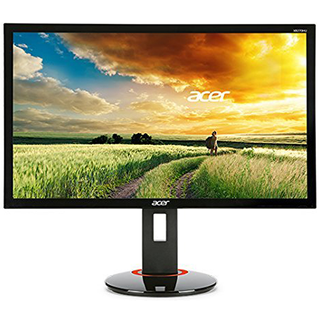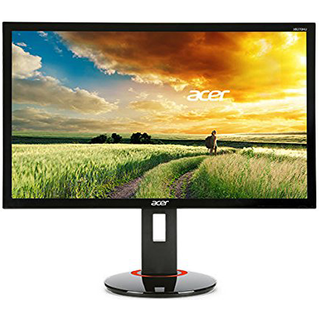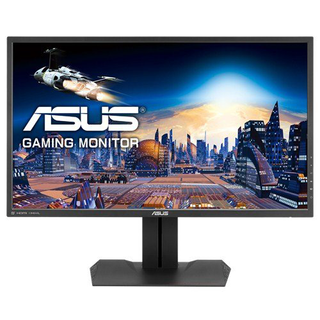ViewSonic XG2700-4K 27-inch Ultra HD FreeSync Monitor Review
If you're looking for FreeSync, IPS and Ultra HD in one product, choices are slim. ViewSonic has entered this rarified category with a phenomenal effort in the XG2700-4K. This 27-inch monitor is one of the best displays we've ever tested.
Why you can trust Tom's Hardware
Brightness And Contrast
To read about our monitor tests in-depth, please check out Display Testing Explained: How We Test Monitors and TVs. Brightness and Contrast testing is covered on page two.
Uncalibrated – Maximum Backlight Level
We only have one other Ultra HD gaming screen in our database, the TN-based Acer XB280HK. The group's remaining displays run at QHD resolution. In the IPS category is Asus' PG279Q and MG279Q. The other Acer here is the excellent XB270HU. And to add a value-priced Ultra HD monitor to the mix, we've included Monoprice's UHD Matte. It's the only one without adaptive refresh.
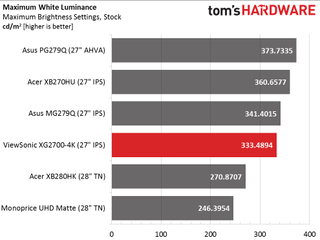
None of the monitors will burn your retinas but they're all bright enough for most situations. The XG2700-4K places just below mid-pack. This is the max output for all the picture modes. If you select sRGB it drops the brightness control to 25, which corresponds to 120cd/m2. You can increase this value if you wish.
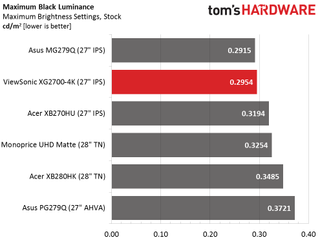
We left our favorite VA panels out of the comparison to make it fair. That tech is after all, in the minority. That being said, the XG2700-4K posts a decent max black level score. We haven't seen too many Ultra HD monitors with deep blacks.

While the ViewSonic doesn't win this comparison, it does have the highest contrast of any Ultra HD monitor we've tested, gaming or otherwise. While extra pixels are nice, we still consider image depth and dynamic range to be a more important mark of quality.
Uncalibrated – Minimum Backlight Level

Dropping brightness to zero yields a relatively useless light level of 15.0029cd/m2. It's not the lowest figure we've seen but it is well below the 50cd/m2 mark where you can actually see a decent image in a dark room. To achieve that, set brightness to 11.
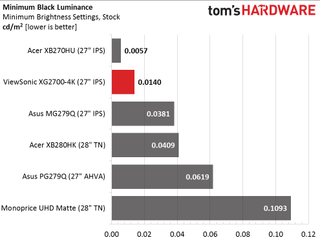
The first two monitors are on top here thanks to their low minimum output, but as you'll see below, the XG2700-4K has great contrast throughout its backlight range.
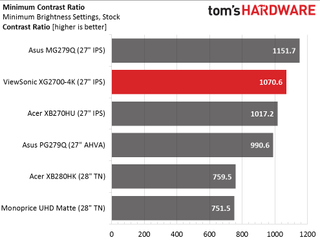
The XG2700-4K stays consistent regardless of your chosen backlight setting. So far, we're seeing the kind of performance we expect at this price point.
After Calibration To 200cd/m2

The XG2700-4K has a uniformity compensation feature. It's an on or off proposition and as you can see, it cuts the white level almost in half. It's not something you'd expect to see in a gaming monitor but then, neither is the factory calibration nor the incredible color accuracy you'll read about on the next two pages. Speaking of uniformity, our tests show it to be exceptional so the compensation is completely unnecessary.

Uni Comp has almost no effect on black levels. It seems to do its thing at the brighter end of the scale.
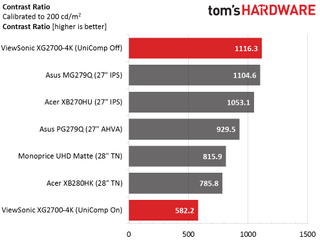
In addition to halving light output, Uni Comp manages to cut contrast by about the same amount. There is definitely no good reason to use it. By the way, calibrated contrast is excellent even after tweaking the RGB sliders.
ANSI Contrast Ratio
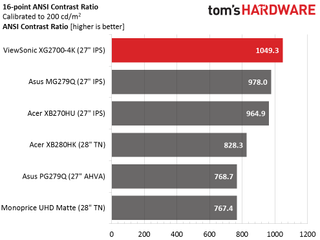
The XG2700-4K is using a very high-quality panel with great screen uniformity and a properly engineered grid polarizer. It's rare that we see over 1000:1 ANSI contrast from any display that isn't VA. The MG279Q and XB270HU come in a close second.
Current page: Brightness And Contrast
Prev Page OSD Setup And Calibration Next Page Grayscale Tracking And Gamma ResponseStay on the Cutting Edge
Join the experts who read Tom's Hardware for the inside track on enthusiast PC tech news — and have for over 25 years. We'll send breaking news and in-depth reviews of CPUs, GPUs, AI, maker hardware and more straight to your inbox.

Christian Eberle is a Contributing Editor for Tom's Hardware US. He's a veteran reviewer of A/V equipment, specializing in monitors. Christian began his obsession with tech when he built his first PC in 1991, a 286 running DOS 3.0 at a blazing 12MHz. In 2006, he undertook training from the Imaging Science Foundation in video calibration and testing and thus started a passion for precise imaging that persists to this day. He is also a professional musician with a degree from the New England Conservatory as a classical bassoonist which he used to good effect as a performer with the West Point Army Band from 1987 to 2013. He enjoys watching movies and listening to high-end audio in his custom-built home theater and can be seen riding trails near his home on a race-ready ICE VTX recumbent trike. Christian enjoys the endless summer in Florida where he lives with his wife and Chihuahua and plays with orchestras around the state.
-
picture_perfect Replytearing artifacts, can be very distracting, especially when the action drops below 40fps
Nope, again tearing is when FPS > refresh.
Judder is when FPS < refresh.
The cause and effect are completely different.
Basic stuff fellas. -
chuckydb Replytearing artifacts, can be very distracting, especially when the action drops below 40fps
And thats why I still have a hard time taking freesync seriously. -
Pailin Replytearing artifacts, can be very distracting, especially when the action drops below 40fps
Nope, again tearing is when FPS > refresh.
Judder is when FPS < refresh.
The cause and effect are completely different.
Basic stuff fellas.
that was one of the sillier comments I've seen in a while. -
Shankovich If you're getting a FreeSync monitor, you should have built a rig that doesn't dip past 60 for most games...Reply -
AlistairAB LG UD68, 27 inch 4K freesync, with calibrated sRGB mode, $449. Poor LG no one is taking notice, I have it and it is great! No need to spend $650 for the same monitor.Reply -
hardarse7 I don't understand why anyone would buy a 4k monitor less than 40" in size. That is four 20" FHD screens. I just bought a Samsung 50" 4k tv to use as a monitor, which is like four 25" FHD screens. It is absolutely brilliant to have so much screen space with no bezels in the middle.Reply -
makah hardarse7 your eyeballs are going to melt out of your head. like the opening of the ark ceremonyReply -
envy14tpe Why would you use a weak GPU, R9-285, to try to game on 4k? At minimum, a Fury should be used.Reply -
picture_perfect ReplyPailin said:that was one of the sillier comments I've seen in a while.
Well they got it wrong the last 15 reviews, so somebody should say something.
-
loki1944 I can't understand the appeal of 27 inch 4K; seems small for that rez. 27 inches is good for 1440p surround, but once I have the gpu grunt for 4K surround I'd be more interested in 30-32 in monitors.Reply
